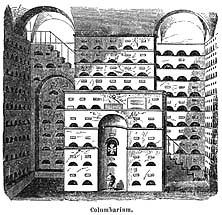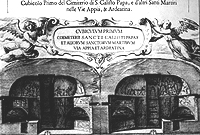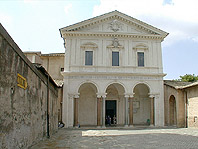Tombs and Catacombs
Tombs and Catacombs
 There are 69 catacombs in the outskirts of Rome and thousands of tombs.
There are 69 catacombs in the outskirts of Rome and thousands of tombs.
Under ancient Roman law, no one could be buried inside the city, for sanitary reasons. All the consular roads were lined with the handsome tombs of patricians, most of whom were cremated and their ashes preserved in urns.
Because they had to be ready for resurrection, the early Christian dead were buried, uncremated, in underground caves hollowed out of soft tufa stone.
It is now generally accepted that these "catacombs" were not where the early Christian community hid from persecution, but where they gathered to honor their dead, particularly martyrs and Popes - usually by staging banquets.
The word “catacomb”, now used for any subterranean burial place, presumably comes from the Greek "hollow," which was the name of the area of stone quarries located around the St. Sebastian catacombs.
Only five of the catacombs are open to the public. There were also six Jewish catacombs, four of which have disappeared. The others, including one at Via Appia Antica 119A, are closed.
Catacombs of St. Callisto
 Here are over 12 miles (17 km) of underground galleries, arranged on four and sometimes five levels, reaching deep down into the earth. They are lined with hollowed-out niches (loculi), frequently two or three high, in which the dead were wrapped in double layers of cloth interspersed with lye to protect the living.
Here are over 12 miles (17 km) of underground galleries, arranged on four and sometimes five levels, reaching deep down into the earth. They are lined with hollowed-out niches (loculi), frequently two or three high, in which the dead were wrapped in double layers of cloth interspersed with lye to protect the living.
The Papal Crypt and the Crypt of St. Cecilia are of religious and historical interest. In the former repose at least five martyred and sanctified Popes who reigned between 230 and 283. Note the marble plaques with the Greek letters MTP for MarTyR.
Pope Damasus I added elegant 4 C decorations. In 821 Pope Paschal I separated St. Cecilia's corpse from that of her husband St. Valerian, and had her re-interred in her own house, now part of the Church of St. Cecilia in Trastevere.
Cecilia-veneration is based on her legendary life and death. Having converted her husband to Christianity and persuaded him to live in chastity, they were guarded by an angel until Emperor Diocletian's persecutions in 303. Valerian, refusing to sacrifice to idols, was martyred first. Cecilia, condemned to death by suffocation in her own bath house in Trastevere, survived for several days while singing hymns - thus making her the Patron Saint of Music. Ordered beheaded, she suffered three ineffectual ax blows, gaining several days during which she made a host of conversions before dying in agony.
![]() In these subterranean tunnels watch for the 2-3 C wall paintings in the Sacraments Crypt and Lucina's Precinct.
In these subterranean tunnels watch for the 2-3 C wall paintings in the Sacraments Crypt and Lucina's Precinct.
![]() At the intersection of Via Appia and Via Ardeatina, the short road from the gate to the tombs is a moment of bucolic calm and beauty before you descend into the somewhat awesome underground labyrinths.
At the intersection of Via Appia and Via Ardeatina, the short road from the gate to the tombs is a moment of bucolic calm and beauty before you descend into the somewhat awesome underground labyrinths.
|
The Amazing History of St. Callisto
History 1C AD. Poor Roman families, Pagan and Christian, formed cooperatives to bury their dead in these tufa stone quarries. 180-192. Emperor Commodus, soft on Christianity, gave in to his mistress Marcia, an enterprising Christian, and freed Church members condemned to hard labor in the mines. With them Calixtus (Callisto), a slave convicted for fraud and brawling in a synagogue, escaped. 199. Calixtus was installed by Pope Zephyrinus as a church deacon and keeper of this cemetery, the first to become legal property of the Christian Church. 217. Calixtus, always enterprising, became Pope. He died five years later and, on dubious evidence of martyrdom, became a Saint. This Christian cemetery was named after him, although he is not one of the several 3 C Popes buried here. 366-384. Pope Damasus I got Emperor Theodosius I to make Christianity the State Religion and restored the catacombs, to prove that Rome's real glory was not pagan. |
Via Appia Antica, 110 – km. 1,8 (Beyond Map Area)
Catacombs and Basilica of St. Sebastian
 These were the first Christian tombs to be known as catacombs, named after this valley. One of the seven pilgrimage churches of Rome, this one is named for St. Sebastian whose remains are among its Holy Relics.
These were the first Christian tombs to be known as catacombs, named after this valley. One of the seven pilgrimage churches of Rome, this one is named for St. Sebastian whose remains are among its Holy Relics.
The catacombs, four levels deep, are similar to those of St. Callisto (above). There are fascinating early paintings, graffiti, stucco work and fine mosaics.
Basilica. In the first chapel to the left in the Baroque church is a smooth white marble sculpture of St. Sebastian lying down full of arrow-holes after a design by Bernini, carried out by Antonio Giorgetti. The adjacent steps lead down to a crypt with the urn containing the Saint's relics.
Other Holy Relics, visited by pilgrims for centuries, are in the right absidal chapel, including what are believed to be a stone with the footprints Jesus Christ left when he met St. Peter fleeing from Rome, arrows which pierced St. Sebastian and the column to which he was bound, as well as the hands of St. Callisto and St. Andrew.
|
Catacombs and Basilica of St. Sebastian
History 1C AD. Three mausoleums built for burying first Pagan, then Christian dead. 258-98. Due to Emperor Valerian's persecutions, St. Peter's and St. Paul's corpses were kept here for 40 years. 288. Sebastian, a Roman officer, was condemned to death for preaching Christianity to the troops. He survived, being riddled with arrows by an execution squad. While recovering, he confronted Emperor Diocletian who had him beaten to death. 4C. Emperor Constantine, Defender of the Faith, built a basilica over the earlier tombs. 1609-12. Cardinal Scipio Borghese had Flaminio Ponzi construct the present church on top of the basilica. |
Via Appia Antica,136 - km. 2,4 (Beyond Map Area)
Catacombs of St. Domitilla
St. Domitilla, related to Emperors Domitian and Vespasian and a member of the distinguished Flavian family, was martyred in 95 AD.
These catacombs, including Christian and non-Christian tombs, were named after her because the entrance was on her property. 18C tomb robbers unfortunately defaced the decorations of her burial place.
There is a particularly lovely tomb with 4C frescoes of Saints Peter and Paul on either side of the dead woman's ghostly black square icon. Under the arch of the tomb, visible only if you kneel, is a Last Supper - a thousand years before Leonardo. Most of the corpses were slotted into shallow slits cut in the stone, many of them were tiny children. Rich people had larger tombs with decorated arches and sometimes separate family vaults.
You can only visit two of the four levels of this largest and perhaps earliest of the catacombs. It is a bit off the beaten Catacomb path, but worth visiting because it is less crowded than those on Via Appia Antica.
Catacombs of Priscilla
As old as those of San Callisto and Sant'Agnese, 2 C AD. Considered the most remarkable for its early frescoes, a 210 AD Madonna with child, and 3C Old and New Testament scenes.
Guided tours. Open 8:30 am - noon, 2:30 pm to 5 pm. Closed Monday.